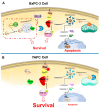Different Cytotoxic Effects of Cisplatin on Pancreatic Ductal Adenocarcinoma Cell Lines
- PMID: 39769425
- PMCID: PMC11727771
- DOI: 10.3390/ijms252413662
Different Cytotoxic Effects of Cisplatin on Pancreatic Ductal Adenocarcinoma Cell Lines
Abstract
This study examined the response to cisplatin in BxPC-3, Mia-Paca-2, PANC-1, and YAPC pancreatic cancer lines with different genotypic and phenotypic characteristics, and the mechanisms associated with their resistance. BxPC-3 and MIA-PaCa-2 cell lines were the most sensitive to cisplatin, while YAPC and PANC-1 were more resistant. Consistently, in cisplatin-treated BxPC-3 cells, the cleavage patterns of pro-caspase-9, -7, -3, and PARP-1 demonstrated that they were more sensitive than YAPC cells. The autophagic pathway, promoting cisplatin resistance, was active in BxPC-3 cells, as demonstrated by the time-dependent conversion of LC3-I to LC3-II, whereas it was not activated in YAPC cells. In cisplatin-treated BxPC-3 cells, Bcl-2 decreased, while Beclin-1, Atg-3, and Atg-5 increased along with JNK1/2 phosphorylation. Basal levels of phosphorylated ERK1/2 in each cell line were positively correlated with cisplatin IC50 values, and cisplatin caused the activation of ERK1/2 in BxPC-3 and YAPC cells. Furthermore, ERK1/2 pharmacological inactivation increased cisplatin lethality in both BxPC-3 and YAPC cells, suggesting that p-ERK1/2 may be related to cisplatin resistance of PDAC cells. Different mechanisms and strategies are generally required to acquire drug resistance. Here, we partially explain the other response to cisplatin of BxPC-3 and YAPC cell lines by relating it to the role of ERK pathway.
Keywords: apoptosis; cisplatin; cytotoxicity; pancreatic ductal adenocarcinoma; signal transduction.
Conflict of interest statement
The authors declare no conflicts of interest.
Figures






Similar articles
-
Resveratrol-induced autophagy and apoptosis in cisplatin-resistant human oral cancer CAR cells: A key role of AMPK and Akt/mTOR signaling.Int J Oncol. 2017 Mar;50(3):873-882. doi: 10.3892/ijo.2017.3866. Epub 2017 Jan 30. Int J Oncol. 2017. PMID: 28197628
-
Inhibition of Survival Pathways MAPK and NF-kB Triggers Apoptosis in Pancreatic Ductal Adenocarcinoma Cells via Suppression of Autophagy.Target Oncol. 2016 Apr;11(2):183-95. doi: 10.1007/s11523-015-0388-3. Target Oncol. 2016. PMID: 26373299
-
Triptolide induces cell death in pancreatic cancer cells by apoptotic and autophagic pathways.Gastroenterology. 2010 Aug;139(2):598-608. doi: 10.1053/j.gastro.2010.04.046. Epub 2010 Apr 29. Gastroenterology. 2010. PMID: 20434451 Free PMC article.
-
ARHI (DIRAS3)-mediated autophagy-associated cell death enhances chemosensitivity to cisplatin in ovarian cancer cell lines and xenografts.Cell Death Dis. 2015 Aug 6;6(8):e1836. doi: 10.1038/cddis.2015.208. Cell Death Dis. 2015. PMID: 26247722 Free PMC article.
-
KRas4B-PDE6δ complex stabilization by small molecules obtained by virtual screening affects Ras signaling in pancreatic cancer.BMC Cancer. 2018 Dec 29;18(1):1299. doi: 10.1186/s12885-018-5142-7. BMC Cancer. 2018. PMID: 30594165 Free PMC article.
Cited by
-
In Vitro Evaluation of Electrochemotherapy Combined with Sotorasib in Pancreatic Carcinoma Cell Lines Harboring Distinct KRAS Mutations.Int J Mol Sci. 2025 Jul 24;26(15):7165. doi: 10.3390/ijms26157165. Int J Mol Sci. 2025. PMID: 40806294 Free PMC article.
-
Deciphering cellular heterogeneity and pathway dynamics in urinary samples: a UMAP-Based approach to understanding acute kidney injury.Front Pharmacol. 2025 Aug 18;16:1573469. doi: 10.3389/fphar.2025.1573469. eCollection 2025. Front Pharmacol. 2025. PMID: 40900831 Free PMC article.
References
-
- Grossberg A.J., Chu L.C., Deig C.R., Fishman E.K., Hwang W.L., Maitra A., Marks D.L., Mehta A., Nabavizadeh N., Simeone D.M., et al. Multidisciplinary standards of care and recent progress in pancreatic ductal adenocarcinoma. CA Cancer J. Clin. 2020;70:375–403. doi: 10.3322/caac.21626. - DOI - PMC - PubMed
MeSH terms
Substances
Grants and funding
LinkOut - more resources
Full Text Sources
Medical
Research Materials
Miscellaneous

